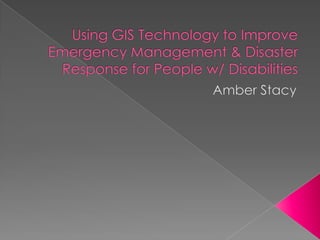Using GIS Technology to Improve Emergency Management
•
3 recomendaciones•1,613 vistas
Denunciar
Compartir
Denunciar
Compartir

Recomendados
Recomendados
Más contenido relacionado
La actualidad más candente
La actualidad más candente (20)
Geographical Information System (GIS) Georeferencing and Digitization, Bihar ...

Geographical Information System (GIS) Georeferencing and Digitization, Bihar ...
Role of GIS in Health Care Management by Dr. Dipti Mukherji

Role of GIS in Health Care Management by Dr. Dipti Mukherji
Destacado
REQUISITOS PARA INGRESAR AL SERVICIO CIVIL: Se hace un desarrollo normativo de los requisitos que exige la Ley del Servicio Civil para ingresar al servicio del Estado (AUTOR: JOSÉ MARÍA PACORI CARI)Desarrollo normativo de los requisitos para ingresar al servicio civil según ...

Desarrollo normativo de los requisitos para ingresar al servicio civil según ...Corporación Hiram Servicios Legales
Destacado (11)
Desarrollo normativo de los requisitos para ingresar al servicio civil según ...

Desarrollo normativo de los requisitos para ingresar al servicio civil según ...
Similar a Using GIS Technology to Improve Emergency Management
Similar a Using GIS Technology to Improve Emergency Management (20)
Digital cartography and natural disaster management

Digital cartography and natural disaster management
CLEARINGHOUSE FOR GEO-SPATIAL DATA FOR AN EMERGENCY PERSPECTIVE

CLEARINGHOUSE FOR GEO-SPATIAL DATA FOR AN EMERGENCY PERSPECTIVE
INTEGRATION OF REMOTE SENSING DATA WITH GEOGRAPHIC INFORMATION SYSTEM (GIS): ...

INTEGRATION OF REMOTE SENSING DATA WITH GEOGRAPHIC INFORMATION SYSTEM (GIS): ...
Volunteered Geographic Information (VGI) for Disaster Management

Volunteered Geographic Information (VGI) for Disaster Management
The Evolving Role of GIS in Hospital and Healthcare Emergency Management 

The Evolving Role of GIS in Hospital and Healthcare Emergency Management
I have a discussion in class Please read and brief the foll.docx

I have a discussion in class Please read and brief the foll.docx
URISA GIS/Health Conf. -- "The Evolving Role of GIS in Hospital/Healthcare Em...

URISA GIS/Health Conf. -- "The Evolving Role of GIS in Hospital/Healthcare Em...
Más de AmberStacy
Más de AmberStacy (8)
Using GIS Technology to Improve Emergency Management
- 1. Using GIS Technology to Improve Emergency Management & Disaster Response for People w/ Disabilities Amber Stacy
- 2. Study Study was conducted in 2007 Conducted by Alexandra Enders & Zachary Brandt at the Research & Training Center on Disabilities at the University of Montana. Federal Transit Administration requested this study.
- 3. Background Individuals with disabilities are especially sensitive to catastrophic events, i.e. natural disasters. State disability policy advocates needed a way to get disability-relevant, geospatial data integrated in such a way as to enhance emergency planning, disaster response, recovery & record management.
- 4. Disability-Relevant Data Overall community resources Population density Physical characteristics of the local environment Transportation capacity, availability, & options
- 5. Objectives Natural disasters do not respect city, county, or state boundaries or governmental jurisdictions. Therefore, when disasters cross these boundaries, it often reveals variations in administrative responses to the same event. GIS technology provides a way to identify these differences, which can lead to policy changes Better understanding & cooperation between various agencies overall improvement in the emergency planning & response systems
- 6. Why GIS? GIS provides various tools to represent & better understand person to environment interactions. GIS enhances the usefulness of data for decision making; for example during some kind of crisis, effective response & recovery includes: Incident mapping Establishing priorities Developing action plans Implementing plans
- 7. Why GIS? GIS allows disaster relief managers to access & visually display critical information by location. Information can be shared with disaster response personnel to coordinate & implement efforts quickly. Mobile GIS allows command centers to stay in touch with personnel at the location of the incident to gather data critical for real-time decision making.
- 8. Methods ArcGIS 9.1 was used to create maps, which included: Census TIGER shapefiles for state & county boundaries. Zip code shape files from the ESRI data disk. Data from RTC (Research & Training Center on Disabilities) 2004 survey of all U.S. CIL (Center for Independent Living) offices, transportation assistance agencies & organizations, & emergency shelters. Data from the CDC’s (Centers for Disease Control) Emergency Operations Center. A lot of this data was gathered post Hurricane Katrina Other shapefiles were used that were previously & internally created for other projects.
- 9. Results Catastrophic events, like Hurricane Katrina, prove that there are significant gaps in emergency planning. This has led to increased accessibility of transportation, housing, & emergency shelters before, during, & after disasters. Also shows the necessity of having current data collected, organized, & available which is invaluable in emergency planning & immediate response. “It’s too late to collect data when the Earth shakes & the water rises”
- 10. Results This study has also shown us that even though certain resources were in close proximity to a particular disaster affected area, the information & data were not tied together & only available in separate nonintegrated database systems. Therefore planning could not be done to effectively utilize those resources. Unfortunately, causing unnecessary suffering & death.
- 13. This map combines the locations of 390 CIL main offices and the distribution of people with disabilities by county.
- 18. References Enders, A., & Brandt, Z. (2007). Using Geographic Information System Technology to Improve Emergency Management and Disaster Response for People with Disabilities. Journal of Disability Policy Studies , Vol. 17. (No. 4). pp. 223-229. U.S. Department of Health & Human Services and Homeland Security. (2006). Working Conference on Emergency Management and individuals with Disabilities and the Elderly. Data Resources for Emergency Planners and Responders. pp. 1-66. Washington, D.C.